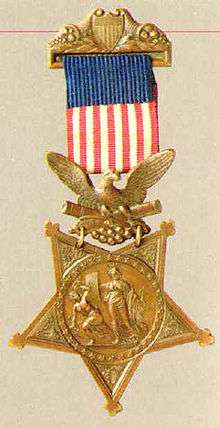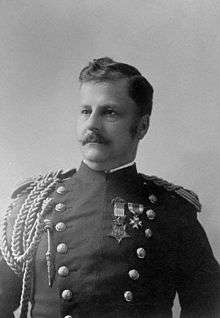Arthur MacArthur Jr.
Lieutenant General Arthur MacArthur Jr. (June 2, 1845 – September 5, 1912), was a United States Army general. He became the military Governor-General of the American-occupied Philippines in 1900 but his term ended a year later due to clashes with the civilian governor, future President William Howard Taft. His son, Douglas MacArthur, was one of only five men promoted to the five-star rank of General of the Army during World War II. In addition to their both being promoted to the rank of general officer, Arthur MacArthur Jr. and Douglas MacArthur also share the distinction of having been the first father and son to each be awarded a Medal of Honor.
Early life
Born in Chicopee Falls, then part of Springfield, Massachusetts, MacArthur was the father of General Douglas MacArthur, as well as Arthur MacArthur III, a captain in the Navy who was awarded the Navy Cross in World War I. His own father, Arthur MacArthur Sr., was the fourth governor of Wisconsin (albeit for only four days) and a judge in Milwaukee.[1]
Civil War
At the outbreak of the Civil War, MacArthur was living in Wisconsin. On August 4, 1862, at the age of 17, he was commissioned as a first lieutenant and appointed as adjutant of the 24th Wisconsin Volunteer Infantry Regiment, seeing action at Chickamauga, Stones River, Chattanooga, the Atlanta Campaign and Franklin.
At the Battle of Missionary Ridge on November 25, 1863, during the Chattanooga Campaign, the 18-year-old MacArthur inspired his regiment by seizing and planting the regimental flag on the crest of Missionary Ridge 35°1′7.15″N 85°15′51.02″W / 35.0186528°N 85.2641722°W at a particularly critical moment, shouting "On Wisconsin." For these actions, he was awarded the Medal of Honor. He was brevetted colonel in the Union Army the following year. Only 19 years old at the time, he became nationally recognized as "The Boy Colonel" (not to be confused with Henry K. Burgwyn, known as the "Boy Colonel of the Confederacy").
MacArthur was severely wounded in the Battle of Franklin, receiving bullet wounds to the chest and leg from a rebel officer's pistol, but would ultimately survive. [2]
He was promoted to major on January 25, 1864, and to lieutenant colonel on May 18, 1865 – shortly before he was mustered out of service on June 10, 1865.
In recognition of his gallantry in action he received brevets (honorary promotions) to lieutenant colonel and colonel dated March 15, 1865.
Indian Wars
With the conclusion of the Civil War in June 1865, MacArthur resigned his commission and began the study of law. After just a few months, however, he decided this was not a good fit for him, so he resumed his career with the Army. He was recommissioned on February 23, 1866, as a second lieutenant in the Regular Army's U.S. 17th Infantry Regiment, with a promotion the following day to first lieutenant. Because of his outstanding record of performance during the Civil War, he was promoted in September of that year to captain. However, he would remain a captain for the following two decades, as promotion was slow in the small peacetime army.
Between 1866 and 1884, MacArthur and his wife (Mary Pinkney "Pinky" Hardy MacArthur, 1852–1935) completed assignments in Pennsylvania, New York, Utah Territory, Louisiana, and Arkansas.[3] Three children were born during this time:
- Arthur MacArthur III (born on August 1, 1876, died December 2, 1923 of appendicitis
- Malcolm MacArthur (born October 17, 1878, died 1883 of measles)[4]
- Douglas MacArthur (born January 26, 1880, died April 5, 1964), at the Arsenal Barracks in Little Rock, Arkansas[5][6]
In 1884, MacArthur became the post commander of Fort Selden, in New Mexico. The following year, he took part in the campaign against Geronimo. In 1889, he was promoted to Assistant Adjutant General of the Army with the rank of major, and was promoted to lieutenant colonel in 1897.
Spanish–American War
Following the outbreak of the Spanish–American War, MacArthur was serving as the adjutant general of the Third Army Corps in Georgia. In June 1898 he was brevetted to brigadier general in the volunteer army. He was appointed as commanding general of the 1st Brigade, 2nd Division, Eighth Army Corps and led it to victory at the Battle of Manila on August 12, 1898. He was promoted to major general on August 13, 1898.
Philippine–American War
He led the 2nd Division of Eighth Corps during the Philippine–American War at the Battle of Manila (1899), the Malolos campaign and the Northern Offensive. When the American occupation of the Philippines turned from conventional battles to guerrilla warfare, MacArthur commanded the Department of Northern Luzon. In January 1900, he was appointed Brigadier General in the Regular Army and was appointed military governor of the Philippines with command of Eighth Corps, replacing General Elwell S. Otis.
He authorized the expedition, under General Frederick Funston, that resulted in the capture of Emilio Aguinaldo. MacArthur persuaded the captured Aguinaldo to cease fighting and to swear allegiance to the United States. He was promoted to major general in the Regular Army on February 5, 1901.
After the war, President William McKinley named him Military Governor of the Philippines, but the following year, William Howard Taft was appointed as Civilian Governor. Taft and MacArthur clashed frequently. So severe were his difficulties with Taft over U.S. military actions in the war that MacArthur was eventually relieved and transferred to command the Department of the Pacific, where he was promoted to lieutenant general.
Return to the United States
In the years that followed, he was assigned to various stateside posts and in 1905 was sent to Manchuria to observe the final stages of the Russo-Japanese War and served as military attaché to the U.S. Embassy in Tokyo. He returned to the U.S. in 1906 and resumed his post as Commander of the Pacific Division. That year the position of Army Chief of Staff became available and he was then the highest-ranking officer in the Army as a lieutenant general (three stars). However, he was passed over by Secretary of War William Howard Taft. He never did realize his dream of commanding the entire Army.
Retirement and death
MacArthur retired from the Army on June 2, 1909, having reached the mandatory retirement age of 64. He was one of the last officers on active duty in the Army who had served in the Civil War.
MacArthur was elected a member of the Military Order of the Loyal Legion of the United States (MOLLUS) in 1868 and was assigned insignia number 648. On May 6, 1908 he was elected commander of the Wisconsin Commandery of MOLLUS. He was elected as the Order's senior vice commander in chief on October 18, 1911, and became the Order's commander in chief upon the death of Rear Admiral George W. Melville on March 17, 1912.
On September 5, 1912, he went to Milwaukee to address a reunion of his Civil War unit. While on the dais, he suffered a heart attack and died there, aged 67. He was originally buried in Milwaukee on Monday, September 7, 1912, but was moved to Section 2 of Arlington National Cemetery in 1926. He is buried among other members of the family there, while his son Douglas chose to be buried in Norfolk, Virginia.
Awards and honors
Military awards
- Medal of Honor
- Civil War Campaign Medal
- Indian Campaign Medal
- Spanish Campaign Medal
- Philippine Campaign Medal.
Medal of Honor citation

Rank and Organization:
- First Lieutenant, and Adjutant, 24th Wisconsin Infantry. Place and date: At Missionary Ridge, Tenn., November 25, 1863. Entered service at: Milwaukee, Wis. Birth: Springfield, Mass. Date of issue: June 30, 1890.
Citation:
Seized the colors of his regiment at a critical moment and planted them on the captured works on the crest of Missionary Ridge.[7][8][9]
Just over eight decades later (1864–1945), his son, Douglas MacArthur, would also gain fame for leading U.S forces to victory in the Philippines. Arthur MacArthur Jr. and Douglas MacArthur were the first father and son ever to each be awarded a Medal of Honor. To date, the only other father and son to be given this honor are former President Theodore Roosevelt and his son, Theodore Roosevelt Jr.
Namesake
Fort MacArthur, which protected the San Pedro, California, harbor from 1914 until 1974, was named after General Arthur MacArthur. Camp MacArthur, a World War I training camp in Waco, Texas, was also named for the General.[10]
Promotions
- First Lieutenant, 24th Wisconsin Volunteer Infantry Regiment, Union Army – August 4, 1862
- Major, 24th Wisconsin Volunteer Infantry Regiment, Union Army – January 25, 1864
- Brevet Lieutenant Colonel and Brevet Colonel – March 13, 1865
- Lieutenant Colonel, 24th Wisconsin Volunteer Infantry Regiment, Union Army – May 18, 1865
- Mustered out of Volunteer service – June 10, 1865
- Colonel, 24th Wisconsin Volunteer Infantry Regiment, Union Army – June 13, 1865 (Commissioned but not mustered)
- Second Lieutenant – February 23, 1866
- First Lieutenant – February 24, 1866
- Captain – July 28, 1866
- Major – July 1, 1889
- Lieutenant Colonel – May 26, 1896
- Brigadier General of Volunteers – May 27, 1898
- Major General of Volunteers – August 13, 1898
- Brigadier General (Regular Army) – January 2, 1900
- Major General – February 5, 1901
- Lieutenant General – September 15, 1906
In fiction and media
- Portrayed by James Paolleli in the 2012 Filipino film, El Presidente.
- Portrayed by Miguel Faustmann in the 2015 Filipino film, General Luna.
- Character in alternate history novel 1901 by Robert Conroy
See also
References
- ↑ 3 governors held office within weeks, Dennis McCann. Milwaukee Journal Sentinel, December 10, 1998.
- ↑ http://www.civilwar.org/battlefields/franklin/ten-facts/ten-facts-about-the-battle-of.html
- ↑ MacArthur 1964, pp. 13–14.
- ↑ James 1970, p. 25.
- ↑ James 1970, p. 23.
- ↑ "From Turbulence to Tranquility: The Little Rock Arsenal Part 2". MacArthur Museum of Arkansas Military History. Retrieved May 23, 2010.
- ↑ Americancivilwar.com (2010). "Civil War Medal of Honor citations". Americancivilwar.com. Retrieved 23 May 2010.
- ↑ Congressional Medal of Honor Society (2010). "MacArthur, Arthur Jr.". Mt. Pleasant, South Carolina: Congressional Medal of Honor Society. Retrieved May 23, 2010.
- ↑ "Medal of Honor recipients: Civil War (M-Z)". Fort Lesley J. McNair, Washington, DC: United States Army Center of Military History. May 21, 2010. Archived from the original on June 4, 2010. Retrieved May 23, 2010.
- ↑ "Camp MacArthur". Texas State Historical Association. Retrieved April 16, 2012.
Bibliography
Further reading
- Young, Kenneth Ray (1994). The General's General: The Life and Times of Arthur MacArthur. Boulder, Colorado: Westview Press. ISBN 0-8133-2195-6.
External links
- "Bio and gravesite photo of Arthur MacArthur Jr.". Retrieved September 24, 2010.
- "Civil War Medal of Honor recipients (M-Z)". Medal of Honor citations. United States Army Center of Military History. August 3, 2009. Archived from the original on July 7, 2010. Retrieved July 1, 2010.
- "Photograph on the cover of the New York Tribune, Memorial Day". May 30, 1909. Retrieved September 24, 2010.
| Government offices | ||
|---|---|---|
| Preceded by Elwell Stephen Otis |
Military Governor of the Philippines May 5, 1900 – July 4, 1901 |
Succeeded by William Howard Taft |

.svg.png)